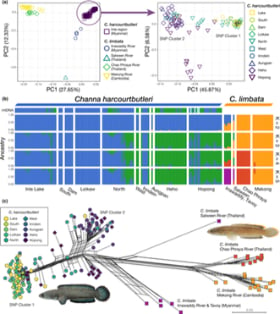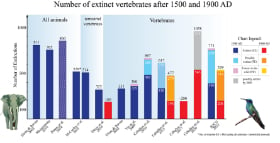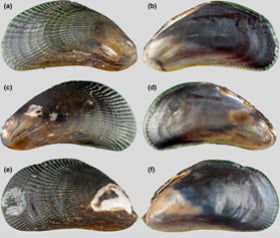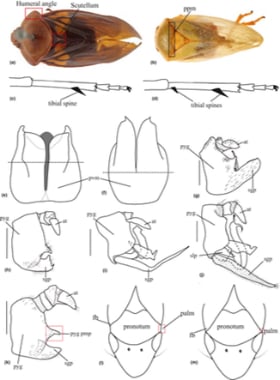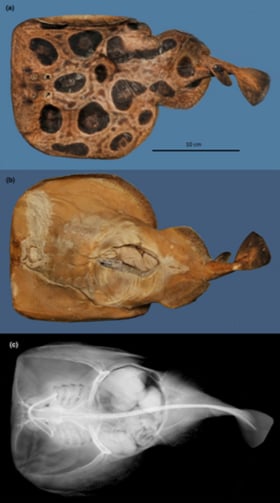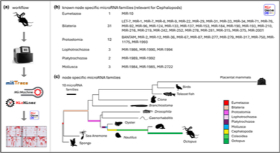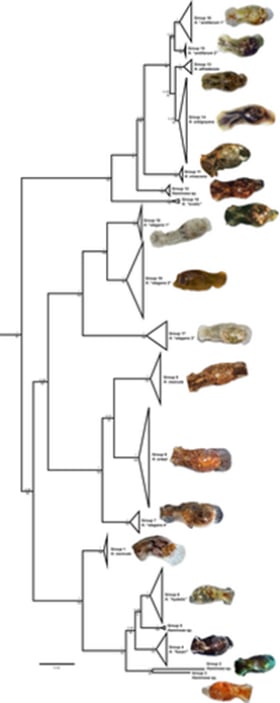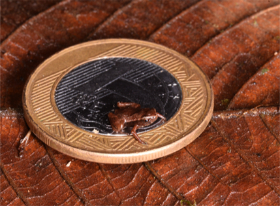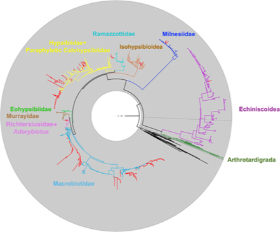Journal list menu
Table of Contents
A new antshrike (Aves: Thamnophilidae) endemic to the Caatinga and the role of climate oscillations and drainage shift in shaping cryptic diversity of Neotropical seasonal dry forests
- First Published: 17 June 2024
Abstract: The Caatinga is the largest patch of Seasonal Dry Tropical Forest in the Neotropics, located in northeastern Brazil and characterized mainly by deciduous vegetation and extreme rainfall seasonality. It has historically been treated as a biologically impoverished domain, but recent studies uncovered new diversification patterns and several new taxa of frogs, mammals, insects, and fishes. Here we employed a dense sampling regime to evaluate whether the São Francisco River (SFR) would have promoted genetic diversification and fixed phenotypic differences and how Quaternary climatic oscillations shaped distribution and population sizes in a Caatinga endemic species, the Silvery-cheeked Antshrike (Sakesphoroides cristatus). We adopted an integrative approach using multilocus genetic, plumage, vocal data, and ecological niche modelling (ENM) to characterize evolutionary units and niche suitability in past scenarios. We recovered strong genetic structure across the SFR that was congruent with plumage and vocal variation, revealing a yet undescribed species named herein as Sakesphoroides niedeguidonae, sp. nov. (urn:lsid:zoobank.org:act:2B9FC637-008A-4E9A-B92B-69ED7FE23823s). The splitting time estimated between the newly described species and S. cristatus is consistent with the establishment of the modern course of SFR, with a more recent course shift apparently promoting the secondary contact between the two species in the Raso da Catarina region. After their split, both species experienced increases in population sizes and range sizes at similar times during the Last Glacial Maximum. We expect other Caatinga avian endemic lineages to show similar patterns of genetic differentiation across the SFR that were enhanced by Quaternary climatic oscillations.
Origin of endemic species in a moderately isolated ancient lake: The case of a snakehead in Inle Lake, Myanmar
- First Published: 24 September 2023
Abstract: Inle Lake is an ancient lake in Myanmar, which is an important area with unique and diverse fauna. Its ichthyofauna is believed to have formed non-radiatively, but the historical processes are poorly understood. To elucidate the mechanisms that shape species diversity in this moderately isolated biogeographical ‘island’, this study focused on a typical endemic fish of Inle Lake, Channa harcourtbutleri (Channidae, Anabantiformes), with its widely distributed sister species, C. limbata, and estimated the historical distribution and diversification processes of the endemic fish based on genome-wide polymorphism (MIG-seq) and mitochondrial DNA data. Channa harcourtbutleri contained two genetically and morphologically distinct groups inhabiting Inle Lake and the surrounding rivers respectively. These two groups were genetically the closest to each other; however, the riverine group showed some similarity to the closely related species, C. limbata from Southeast Asia. The mtDNA haplotypes of the endemic species were not monophyletic; most of the riverine group had haplotypes identical or close to those of C. limbata from the upper Irrawaddy and Salween rivers. The time tree suggested that C. harcourtbutleri diverged from C. limbata in the early Pleistocene and then experienced secondary contact with C. limbata in the late Pleistocene. Genetic and morphological differentiation within C. harcourtbutleri suggests that local adaptation to different environments has played an important role for the coexistence of its two forms with some reproductive isolation. Further, the results highlight the importance of multiple colonization and allopatric speciation in shaping biodiversity in the long-term, moderately isolated environments.
On the end of evolution – Humankind and the annihilation of species
- First Published: 03 March 2023
Abstract: For too long and with ever-increasing ferocity during the past decades of an exponentially growing human world population, humankind has been waging a genuine war against nature, of which we ourselves are nevertheless also a part. We are plundering the unique biological treasure, the diversity of species, without which the ecosystems we rely on for our food, our water and so much more would not function. At present, we are already in the midst of a massive decline of populations and species, with a significantly higher extinction rate than the long-term average. Driven essentially by habitat loss and degradation, direct exploitation through legal and illegal hunting and fishing as well as pesticides and pollution, within decades, 1 million species out of a total of 8 million could go extinct. Alongside climate change, this dramatic decay of biodiversity, that involves also the subsequent loss of ecosystem services, here termed ‘the end of evolution’, is another and by no means lesser threat to humanity. We can still take countermeasures, but we must transform our economy and change our way of living. As most successful strategy the protection of up to 30% of Earth's surface by 2030 was suggested, ideally based on the implementation of a consistent framework of global ecosystems, as it was agreed on by the December 2022 United Nations Conference of Parties (COP15) Montreal meeting for the Conservation on Biological Diversity.
A new lineage of fresh- and brackish-water mussels (Bivalvia, Mytilidae) from Southeast Asia
- First Published: 21 February 2023
Abstract: Three species of mussels collected from fresh- and low salinity (10 psu or lower) brackish-water environments in southern Thailand, Singapore, northern Borneo and south Sulawesi formed a new, well-supported and distinct mytilid clade based on molecular phylogeny. All are small (< 30 mm) species with either radially ribbed or smooth shells. Internally, the upper edges of the ascending lamellae of the outer and inner demibranchs are, respectively, fused to the mantle lobes and visceral mass. A new genus Parabrachidontes is proposed to accommodate the three species. Of the species in the new genus, one is described as new (Parabrachidontes amnicus sp. n.), and the other two poorly known species (P. leucostictus and P. cochinensis) are re-described. The Parabrachidontes clade is closely related to Mytella, Perna and Arcuatula. Together, they formed a well-supported clade, most members of which have ctenidial edges attached to the mantle and/or visceral mass. These genera are clearly distinct phylogenetically from two other mytilid clades containing brackish- and fresh-water species with ctenidia free of the mantle: one comprising the genera Limnoperna and Sinomytilus (together constituting the Limnoperninae), and the other Xenostrobus and Vignadula (forming the Xenostrobinae). We therefore suggest the existence of at least three lineages of mytilids living in rivers and estuaries of East Asia and Australasia.
Molecular phylogeny of Cercopidae (Hemiptera, Cercopoidea)
- First Published: 02 May 2023
Abstract: With 175 described genera and 1556 described species, Family Cercopidae is currently divided into two subfamilies: the paraphyletic Cercopinae and the monophyletic Ischnorhininae. This study, with emphasis on the family Cercopidae, is in line with the extensive work of Cryan and Svenson which is the first phylogenetic study testing the monophyly of this family and higher-level relationships within Cercopoidea. This study includes more representative taxa from Old World regions. The results of the phylogenetic analysis based on DNA nucleotide sequence data (18S rDNA, 28S rDNA, histone 3, and cytochrome oxidase I) show that Cercopidae is not monophyletic. Three major lineages are recovered: (1) the lineage Microsargane Fowler, 1897 + Hemitriecphora Lallemand, 1949 which is the sister group to Aphrophoridae + Epipygidae, (2) most of the Old World Cercopidae appear as a monophyletic lineage that can be subdivided into two clades, and (3) the monophyletic New World Ischnorhininae, which is separated from the rest of Cercopidae and basal to the two other lineages. It is proposed that Microsargane and Hemitriecphora should be removed from Cercopidae and placed within Aphrophoridae, and only the monophyletic Old World lineage should be kept as Cercopidae sensu stricto. The two subfamilies Cercopinae and Cosmoscartinae, corresponding respectively to the monophyletic lineage groups 2 and 3, should be kept with minimal changes on the tribal level, and the subfamily Ischnorhininae should be raised to family level Ischnorhinidae stat. nov.
From historical expedition diaries to whole genome sequencing: A case study of the likely extinct Red Sea torpedo ray
- First Published: 13 September 2023
Abstract: Torpedo rays (Torpedinidae, Torpediniformes) are small to moderately large batoids that produce an electric discharge. They are distributed worldwide in temperate and tropical seas and are, as a result of their bottom-dwelling behaviour, susceptible to trawl fishing and often end up as victims of bycatch. The distribution ranges of most recognized species seem to be restricted; however, their species-level systematics is not adequately resolved. In the genus Torpedo, in which many species require revision, there are possibly several undescribed species, while numerous misidentifications add to the complexity of the issue. In the latest lists of living rays, 13 species are accepted in the genus Torpedo, including three of doubtful validity and several recently discovered undescribed species. Among the valid species is the critically endangered, possibly extinct, Torpedo suessii Steindachner, 1898, the Red Sea torpedo, of which only four specimens have been recorded in the literature until now, three of which still exist in the fish collection of the Natural History Museum of Vienna. Museum collections are the most important archive of biodiversity on Earth, and are increasingly being used for various studies, including phylogenetics, population genomics, and biogeography. Nevertheless, molecular analysis of old museum material remains challenging because the genetic material has degraded, is fragmented, and of low quantity. In molecular taxonomy, the necessity of including type specimens as name-bearing specimens is increasingly recognized. Here, the extended specimen approach was applied to re-describe the lectotype of T. suessii. The approach included research of historical information and whole genome sequencing, followed by genome assembly and phylogenetic analysis.
A renaissance of microRNAs as taxonomic and phylogenetic markers in animals
- First Published: 21 June 2024
Abstract: Molecular markers for tracing animal sample origins and compositions are critical for applications such as parasite detection, contamination screening, and sample authentication. Among these, microRNAs have emerged as promising candidates due to their deep conservation, near-hierarchical evolution, and stability. I here review the suitability of microRNAs as taxonomic and also phylogenetic markers and show how careful annotation efforts and the establishment of the curated microRNA gene database MirGeneDB and tools like MirMachine have revitalized microRNA research. These advancements enable accurate phylogenetic and taxonomic studies, highlighting microRNAs' potential in resolving long-standing questions in animal relationships and extending to applications in ancient DNA and environmental RNA analysis. Future research must focus on expanding microRNA complements across all Metazoa and further improving annotation methodologies.
Molecular phylogeny of the marine snail genus Haminoea (Gastropoda, Cephalaspidea): A framework to study marine diversity and speciation
- First Published: 18 August 2023
Abstract: Haminoea are herbivorous, coastal snails occurring in temperate and tropical waters of the Atlantic and Eastern Pacific oceans, with one species present in temperate South Africa (Indian Ocean). The genus is taxonomically difficult as several available nominal species were introduced based on shell descriptions alone, or described based on subtle differences in morpho-anatomical features, without a phylogenetic molecular framework. Fifteen species are currently accepted as valid in recent scientific literature and field guides (eight Eastern Atlantic, one temperate Indian Ocean, four Western Atlantic and three Eastern Pacific). Here we generate the first complete phylogeny (Bayesian and Maximum Likelihood) of this genus based on multilocus molecular data (COI, 12S rRNA, 16S rRNA, 28S rRNA) using a taxon set accumulated over a period of 15 years, coupled with species delimitation analyses methods (ABGD, ASAP, bPTP) and morpho-anatomical studies. The goal of this study is to provide insights into the taxonomy, phylogenetic relationships and geographical distributions of species while generating a framework for future systematic reviews of the genus, as well as to study speciation and historical biogeography. Our results rendered four possible hypotheses of species diversity: with 14, 15, 19 and 20 candidate species and point to the fact that several taxa presently regarded as valid might be conspecific (e.g. H. orteai–H. templadoi–H. exigua; and H. alfredensis–H. antillarum–H. orbignyana), while highlighting the existence of a complex of four or five species often identified as H. elegans. Pervasive nomenclatural problems in the genus, including with the type species H. hydatis, are highlighted and discussed.
Zooming in on amphibians: Which is the smallest vertebrate in the world?
- First Published: 07 February 2024
Abstract: During the last decades several miniaturized frogs have been described from different parts of the world. Those frogs, measuring less than 25 mm, show similar miniaturization features as the loss of phalanges in both the anterior and posterior limbs and the reduction of bone elements. However, there seems to be a limit regarding the minimum size of frogs and here we wanted to find an answer to the question: which is the smallest amphibian in the world? In 2019, an endemic species of toad known only from two localities in southern Bahia, Brazil, was studied. When we compared the size of adult representatives of this species with those of other species discovered in various parts of the world in the last decade, we observed that individuals of Brachycephalus pulex are the amphibians with the smallest total length recorded, thus qualifying them to bear the title of the tiniest anuran amphibian, and also tiniest vertebrate in the world.
The wealth of shared resources: Improving molecular taxonomy using eDNA and public databases
- First Published: 21 February 2023
Abstract: Public databases such as the NCBI's GenBank have been used as repositories for genomic studies for more than 30 years. In this time, our understanding of the natural world, and especially the genomic world, has expanded vastly, and the size of these databases represent this genomic revolution. Databases like GenBank now help populate many molecular studies, supplementing a researcher's newly gathered data with publicly available sequences. Despite this, older sequence records, particularly those from understudied taxa, are frequently not updated in line with this burgeoning understanding, and this means that analyses that leverage this public data – from BLAST through to phylogenetic analyses – cannot do so with the full force of its collective understanding. This is particularly true for environmental DNA (eDNA) records, where older sequence records may identify sequences only to the phylum level, limiting their use in many studies. Here, with a case study of tardigrade 18S sequences, the family identities of 630 sequences, previously only identified to the phylum level, were established using 501 family, genus and species level 18S sequences, effectively doubling the depth and taxonomic resolution of tardigrade 18S sequences in GenBank.





